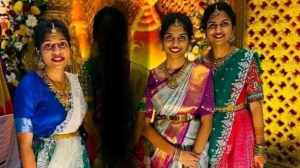Midnight’s children
After 26/11, these Partition stories have an even more anguished resonance n kishwar desai

There can be no greater sense of despair than that experienced while reading stories about Partition, especially post 26/11. Embedded in them is all the residual fallout that has haunted the subcontinent for decades afterwards — a careless drawing of a line that forever endangered lives and created the overarching myth of the “Other”. A myth that many now believe is the reality.
The kernel of all Partition stories lies in the description of the heart of darkness, and Crossing Over, edited by Frank Stewart and Sukrita Paul Kumar, includes voices of almost 20 different authors like Mohan Rakesh, Bhisham Sahni, Khadija Mastur and even Gulzar. Their writing reflects the painful moments when two countries were created, and when women were raped, children stolen, properties usurped and entire histories buried beneath bloodshed and rubble. Reading how the perpetrators went unpunished because the violence was thought inevitable in the transfer of such large populations, you ask yourself if it is any wonder that the same violence still continues unchecked between the two communities. Did the simmering anger ever, really, get resolved? And will we ever find a way to soothe the agony that is evident in these pages?
Some of the stories in this collection are already well known — such as Intizar Husain’s “Basti”, and Saadat Hasan Manto’s “Toba Tek Singh”, and among the essays, the extracts from Urvashi Butalia’s The Other Side of Silence. But fortunately there are also plenty of not so well known gems such as Abul Bashar’s “Rebirth”, the story of Jugin, a Muslim craftsman who has traditionally made the crown for Goddess Lakshmi. Due to the growing rift between the two communities, his benefactor, Shudharani, no longer offers him parshad or honours him in any way after the puja. Wounded, Jugin recites the many names of Krishna to comfort himself. It is a beautifully syncretic story — replete with the nostalgia of a more innocent age.
Brought out by the University of Hawaii to celebrate the anniversary of the independence of the countries of the subcontinent, the stories and essays have been translated from Urdu, Hindi and Bengali, apart from those which were originally written in English. They have been interspersed with evocative photographs from the family album of Teresa Vas Mansson whose family from Goa resettled in Karachi. After Partition, some members of the family moved on to London, and Teresa now lives in Hawaii. While the photographs are themselves extremely interesting, they do not really fit into the theme of forced migration — although they do represent a different kind of crossing over, i.e., migration according to choice. This means a clear disconnect between the anguished printed narrative and the posed and pretty pictures. In fact, rather than present another “degree of suffering”, the photographs reflect a comfortable, westernised family — fairly irrelevant in this book which is largely about the dispossessed.
Of course, as pointed out in the afterword by C.M. Naim from the University of Chicago, it will be interesting if the scope of Partition literature moves beyond Urdu, Punjabi, Hindi, Bengali and even English to regional languages such as Kannada, Malayalam and Marathi — to explore other writing in 1947.
No collection of Partition literature can ever hope to be comprehensive — and this fairly slim collection is an interesting but by no means a comprehensive anthology. A remarkable omission is poetry, but one hopes this will inspire other, perhaps larger, collections which will continue to cover a very important part of our collective history.


- 01
- 02
- 03
- 04
- 05




























